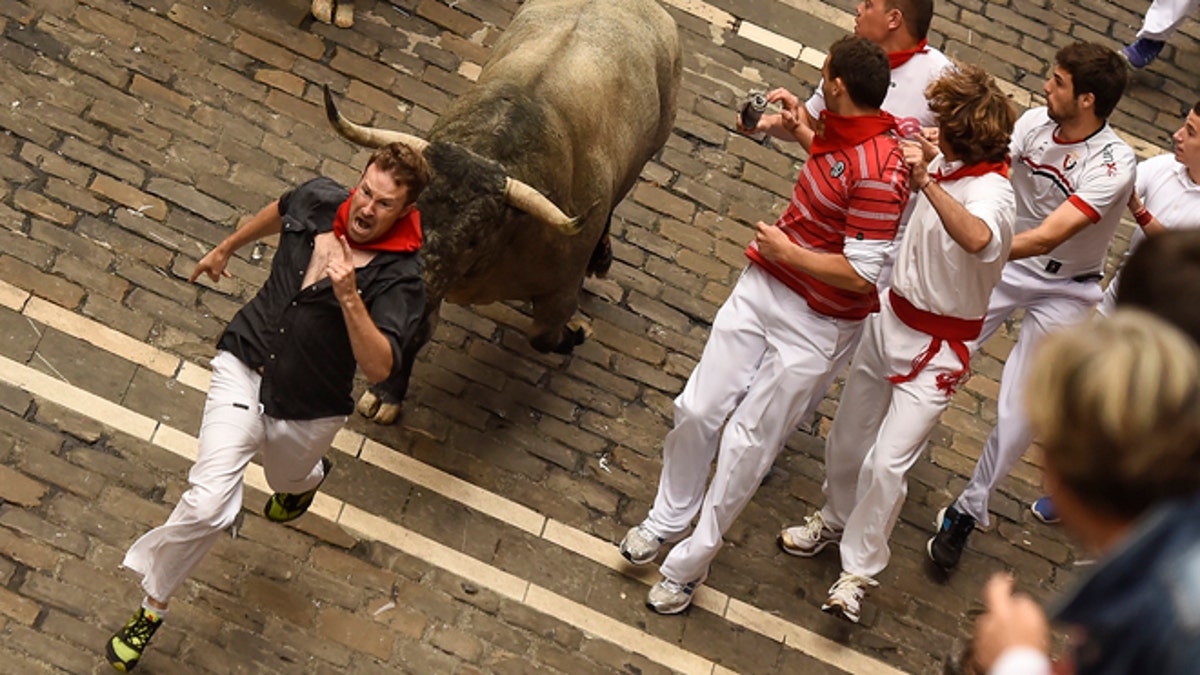
A participant runs in front of a ''Jose Escolar Gil'' fighting bull alongside Mercaderes street, during the fifth running of the bulls, at the San Fermin Festival, in Pamplona, Spain, Saturday, July 11, 2015. Revelers from around the world arrive to Pamplona every year to take part in some of the eight days of the running of the bulls. (AP Photo/Alvaro Barrientos)
PAMPLONA, Spain (AP) – One bull chosen to take part in Saturday's San Fermín festival took one look at thousands of thrill-seekers waiting to be chased down Pamplona's narrow streets and scampered back to the safety of his corral.
It was like a scene straight from Munro Leaf children's book "The Story of Ferdinand," about a bull that prefers smelling flowers to bullfights.
The reticent bull in Pamplona, named Curioso I, barely ran 20 yards (meters) before heading back. Meanwhile, his five ornery stable-mates gored four revelers — including two Americans — and injured five others with cuts and bruises as they hurtled through the northern Spanish city.
One bull charged into runners, goring one deeply in a thigh while cutting another runner's leg as it lifted its head.
Red Cross spokesman José Aldaba said four people received treatment after being gored while at least five others were recovering from sprains, bruises and — in one case — a broken collarbone.
The Americans — both men — were a 34-year-old from Philadelphia identified only by his initials J.N.O., who suffered two gorings, one behind his knee and another near the anus, and a 20-year-old with lesser injuries identified as A.G.O., the regional government said in a statement.
Kiko Betelu of the Navarra region's medical service said three of the gorings were simple to treat, but one of the injuries was deep and required surgery.
Normally six bulls run in the San Fermín festival, but on this occasion Curioso — a 1,180-pound (535-kilogram) beast belonging to the José Escolar breeding ranch — later had to be transported to the ring to join the other five.
Unlike the gentle, flower-sniffing Ferdinand, Curioso — which means curious in English — almost certainly won't get a chance to retire.
According to San Fermín experts commenting for state television TVE, the last time a bull turned back to the holding pen was in the 19th century.
The run covers 930 yards (850 meters) from a holding pen on the edge of town to the central bullring where the beasts — including Curioso — face matadors and almost certain death in afternoon bullfights.
The cobblestone streets of Pamplona were packed with thrill-seekers who had traveled to the northern city to take part in the annual San Fermín festivities. The weekend runs are traditionally the most popular and well-attended.
The nine-day fiesta was immortalized in Ernest Hemingway's 1926 novel "The Sun Also Rises."
Every morning of the festival at 8 a.m., the bulls race through the medieval streets accompanied by an equal number of large steers — each wearing a clanking cowbell — tasked with keeping the pack tight and galloping at an even pace.
This was the first time that breeder Escolar — whose heaviest animal was the 1,280-pound (580-kilogram) Costurero — had presented bulls for this festival, which dates back to the late 16th century.
